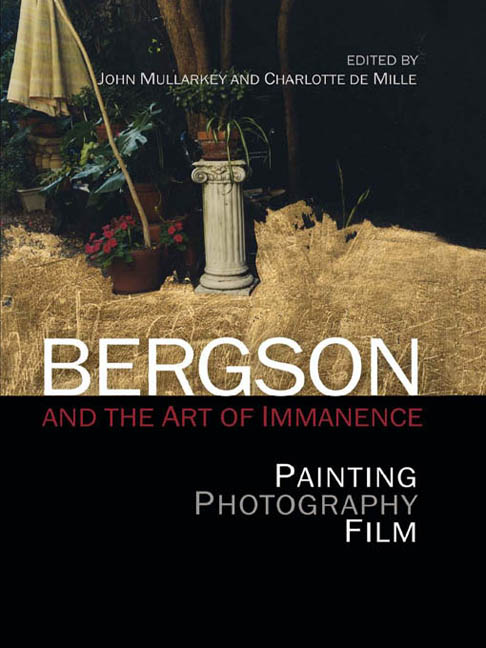Book contents
- Frontmatter
- Contents
- List of Illustrations
- Notes on Contributors
- Introduction: Art's Philosophy – Bergson and Immanence
- Part I Bergson, Art, History
- Part II Unconditional Practice
- 7 The Matter of the Image: Notes on Practice-Philosophy
- 8 Pasearse: Duration and the Act of Photographing
- 9 Duration and Rhetorical Movement
- 10 A Diagram of the Finite-Infinite Relation: Towards a Bergsonian Production of Subjectivity
- Part III Immanence of the Visible
- Afterword: An Art Historical Return to Bergson
- Index
7 - The Matter of the Image: Notes on Practice-Philosophy
from Part II - Unconditional Practice
Published online by Cambridge University Press: 07 December 2017
- Frontmatter
- Contents
- List of Illustrations
- Notes on Contributors
- Introduction: Art's Philosophy – Bergson and Immanence
- Part I Bergson, Art, History
- Part II Unconditional Practice
- 7 The Matter of the Image: Notes on Practice-Philosophy
- 8 Pasearse: Duration and the Act of Photographing
- 9 Duration and Rhetorical Movement
- 10 A Diagram of the Finite-Infinite Relation: Towards a Bergsonian Production of Subjectivity
- Part III Immanence of the Visible
- Afterword: An Art Historical Return to Bergson
- Index
Summary
‘Just walk in a straight line’, says the male voice in the opening of the film titled Swamp. But the body holding the camera cannot comply with these instructions, and the creation of the art form is left for the camera to determine, frame by frame, as it records the process of the camera-body movement. As the body moves within the landscape of soft golden grassed tracks, a pale blue high skyline and browntopped flax-coloured reed stems are forced out of view and the lineforms created are crossed, barriers to movement that are anything but straight. Perceptual conflict arises from these seemingly benign images. What is it that we are seeing? What are these images? As we explore in this chapter, the processes that created them are controlled actions, productive of images that record and make forms, by the direction of their practice.
Swamp is the title of a six-minute colour film with sound, made by American artists Nancy Holt and Robert Smithson in 1970–71. Smithson is the directing voice, and Holt is the camera operator. Filmed on location in reed- and grass-filled land in Bergen County, New Jersey, USA, the film's resonating energy comes from its movement. Shot on 16mm film, transferred to video, the images have the faded cool-toned appearance of those technological processes. Holt is filming through the wind-up Bolex camera, with Smithson's voice giving the directions. The images are given a topological history by the performance of the voice of the artist, overlaying the sound images as they emerge, frame by frame. Boots, straps, equipment, and grasses, reed stems, dirt, mud, grind and crunch as jerky footsteps connect camera and place, moving through the reed, directed by the voices of Holt and Smithson. Looking through the Bolex viewfinder, Holt has camera vision. The camera vision has an unsteady gait and uneven pace. ‘Just walk in a straight line’, he says. ‘I think I am’ she emphatically responds. The sound images connect the practice of this form of processually determined art with the history of recent film work. ‘It's OK’, says Smithson, ‘you're on fairly solid ground.’ This is a false claim as the Bergen County swamplands are unstable ground full of industrial waste.
- Type
- Chapter
- Information
- Bergson and the Art of ImmanencePainting, Photography, Film, Performance, pp. 115 - 130Publisher: Edinburgh University PressPrint publication year: 2013



